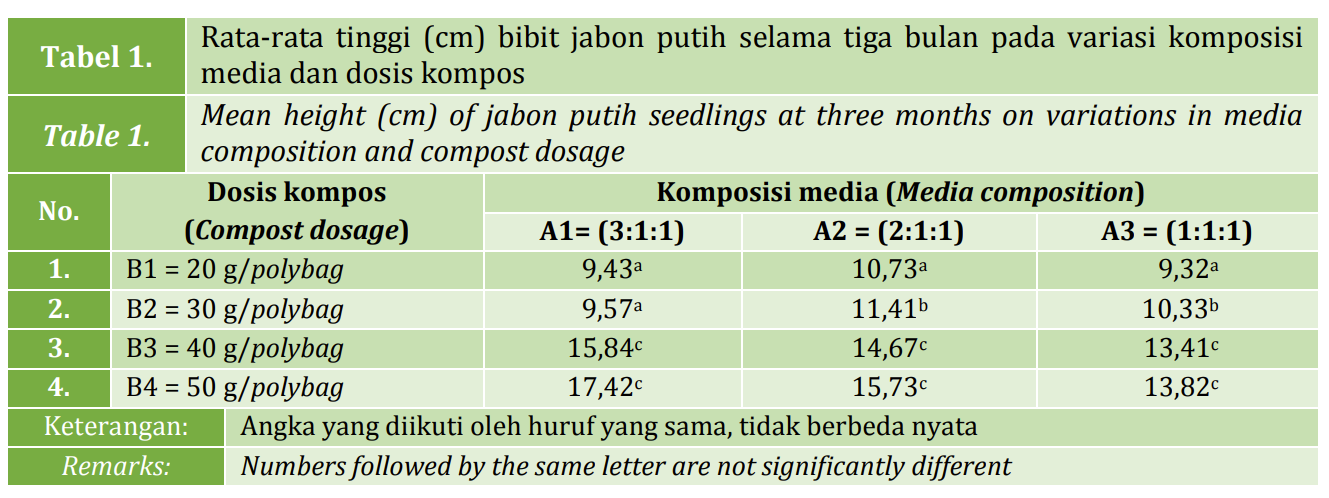The use of various composition media and additional compost to stimulate the growth of jabon putih (Neolamarckia cadamba (Roxb.) Bosser) seedlings

Downloads
Jabon putih (Neolamarckia cadamba (Roxb.) Bosser) is a species of forest plant that is widely grown for pulp raw material of paper and carpentry wood, in plantation forests, village forests, and community lands, so it is necessary to prepare good quality seedlings. This research was conducted for the propagation of jabon putih seedlings by stimulating their growth using various media compositions and compost doses. This research was carried out in the nursery area of the Environmental and Forestry Research and Development Center of Makassar for three months, from October 2019 to January 2020. This study used a completely randomized design with a factorial pattern with four replications. The treatment used various media compositions consisting of soil, sand, husks as the first factor, and compost dose as the second factor. The variables observed were the growth of seedlings including height, stem diameter, and number of leaves. The interaction of media composition and compost dose had a significant effect on the growth of jabon putih seedlings in the nursery. The best media composition was a mixture of soil, husks, and sand with a ratio of 2:1:1 and the provision of 40 g of compost per polybag, which could increase the growth of seedling height by 68.62%.
Aprianis, Y., & Syofia R. (2009). Dimensi serat dan nilai turunannya dari tujuh jenis kayu asal Provinsi Jambi. Jurnal Penelitian Hasil Hutan, 27(1), 11-20.
Artaji, W. (2015). Kompos sebagai pupuk organik yang efektif. Diakses 2 November 2020.
Badan Standarisasi Nasional. (2018). Bibit tanaman hutan. SNI No. 8420.2018. Badan Standarisasi Nasional. Jakarta. https://persemainpermanen.com>files>peraturan. Diakses 31 Januari 2022.
Badan Standarisasi Nasional. (2018). Media bibit tanaman hutan. SNI.5006-2.2018. Badan Standarisasi Nasional. Jakarta. Diakses 17 Mei 2022.
Bachtiar, B. (2018). Peran media tanam dan pemberian pupuk kompos terhadap pertumbuhan anakan jabon merah Anthocepalus macrophyllus di persemaian. BIOMA. Jurnal Biologi Makassar, 3(2). 10-17.
Courtina. (2021). Delapan manfaat kayu jabon dan harga yang wajib diketahui. Luxury Wood Panel & Floring. https://courtina.id/ Posted 5 Agustus 2021.
Cybext. 2019. Manfaat sekam padi sebagai media tanaman. https://cybex.pertanian.go.id Diakses 23 November 2021.
Dwijoseputra, D. (1990). Pengantar Fisiologi Tumbuhan. PT Gramedia Pustaka Utama. Jakarta. Hal 100-103.
Eko, P. (2010). Unsur-unsur makro yang dibutuhkan tanaman. (Online) http:www.ekopras.com/2010/07/06/6-unsur-hara-makro-yang-dibutuhkan-tanaman. Diakses 25 Februari 2021.
EleoNoraBETania. (2014). Apa manfaat tanah pasir bagi tumbuhan. https://brainly.co.id Diakses 23 November 2021.
Hildalita. (2009). Penggunaan sludge pabrik kopi dalam produksi semai jabon (Anthocephalus Cadamba Roxb Miq.). [Skripsi]. Departemen Silvikultur. Bogor: Institut Pertanian Bogor. Hal 17 dan 19.
Indrawan, D., Efiyanti, L., Tampubolon, R.M., & Roliadi, H. (2015). Pembuatan pulp untuk kertas bungkus dari bahan serat alternatif. Jurnal Penelitian Hasil Hutan, 33(4), 283-302.
Ipawati, Dara, S.D., & Dasumiati. (2015). Optimalisasi penggunaan pupuk kompos dengan penambahan effective microorganism 10 (Em10) pada produktivitas tanaman jagung (Zea mays L.). Al-Kauniyah: Jurnal Biologi, 8(2), 77-87.
Irawan, A., & Kafiar Y. (2015). Pemanfaatan cocopeat dan arang sekam padi sebagai media tanam bibit cempaka wasian (Elmerrilia ovalis). Prosiding Seminar Nasional Masyrakat Biodiversity Indonesia (BIOTI), 1(4), 805-808.
Irawan, U.S., Arbiansyah, Abrar R., Henry P., & Sulton A. (2020). Buku manual pembuatan persemaian dan pembibitan tanaman hutan. Operasi Wallaceae Terpadu. Jakarta.
Irmayanti, L., Mariati M., Salam S., & Buamona, R., (2019). Respons pertumbuhan bibit jabon merah (Anthocephalus macrophyllus (roxb.) Havil) di persemaian pada pemberian pupuk hayati dan kimia. EnviroScienteae. Jurnal Ilmiah Bidang Pengelolaan Sumberdaya Alam dan Lingkungan, 15(2), 204-210.
Mosooli, Ch.C, Marthen T. L., Joshepus I. K., & Jos S. (2016). Pengaruh media tumbuh kompos terhadap pertumbuhan bibit jabon merah (Anthocephalus Macropyllus). Cocos, 7(3), 1-11.
Mulyana, D. , Ceng A., & Idhan F., (2010). Bertanam Jabon. AgroMedia. Jakarta Selatan. Hal 12-14 dan 56.
Murbandono. (2007). Membuat Kompos. Penebar Swadaya. Jakarta. Hal 10-11.
Pertanianku. (2020). Pengertian kompos dan kegunaannya untuk kesuburan tanah. Diakses 23 November 2021
Warasfarm. 2013. Pemanfaatan sekam padi sebagai media tanam dan pupuk. Diakses 4 Januari 2021.
Wasis, B. & Dwita N., (2010). Pengaruh pemberian pupuk NPK dan kompos terhadap pertumbuhan semai jabon (Anthocephalus cadamba Roxb Miq.) pada media tanah bekas tambang emas (tailing). Jurnal Ilmu Pertanian Indonesia, 15(1), 14-19.
Wasis, B. & Sandrasari A. (2011). Pengaruh pemberian pupuk kompos terhadap pertumbuhan semai mahoni (Swietenia macrophylla King) pada media tanah bekas tambang emas. Jurnal Silvikultur Tropika, 3(1), 109-112.




